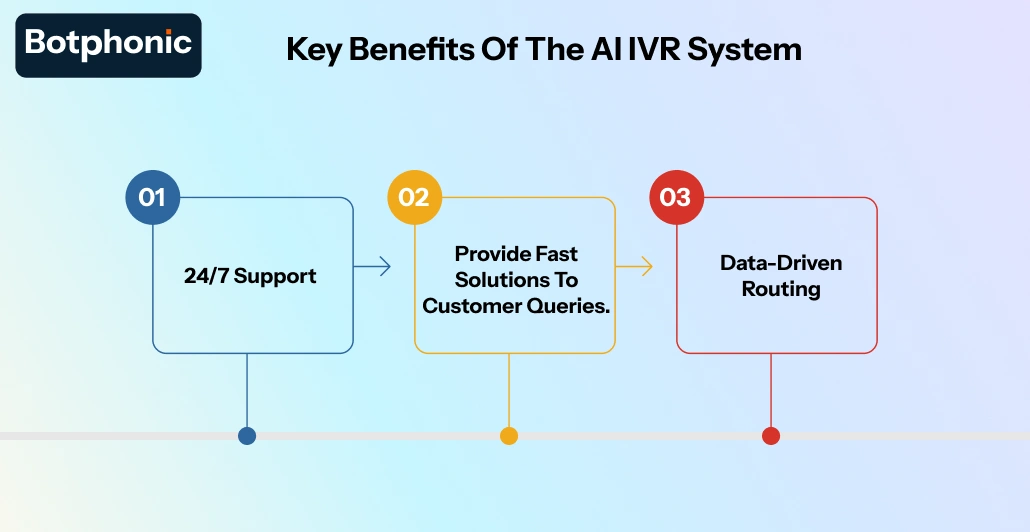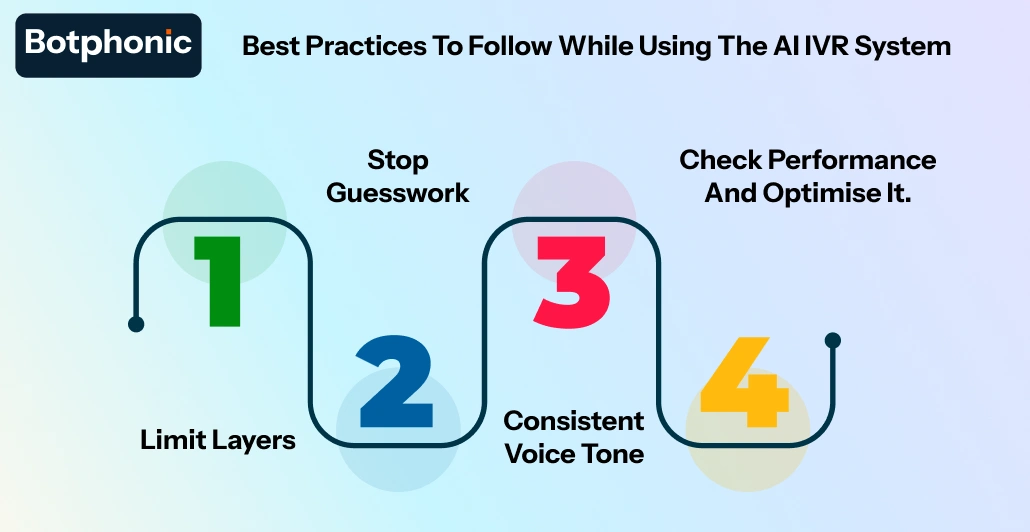
Summarize Content With:
Summary
In this blog, I will provide you with some useful insights on the AI IVR system and its benefits. By reading this blog, you will clear idea about how AI IVR platforms ease the business operations.
Introduction
Call centres are under pressure to provide customers with fast service these days. To resolve their questions, they typically have to press buttons to contact agents.
Traditionally, call centers have taken quite a long and tiresome approach. The agent’s ability to resolve every query in a single day proved challenging; most tickets remained pending or unresolved.
But the good part is that businesses can easily update their old approach by deploying an AI IVR system in the call centers.
These AI-powered IVR are smartly designed and are adept at speech recognition, natural language processing.
A call center’s IVR provides users with a real experience; they can communicate with a natural voice tone instead of pressing buttons.
Customer care IVR accelerates the workflow and minimizes pressure on agents, especially in high-volume scenarios. IVR systems provide fast resolution to customers, and even agents can smoothly use this platform to understand customer queries more accurately.
Key benefits of the AI IVR System

Let me brief you on some benefits of interactive voice response, so that you get a clear understanding before embarking on an automation journey.
1. 24/7 support
Customers have a hectic schedule these days, so they can’t raise a problem during business hours. Sometimes, they raise tickets at midnight and want instant resolution. Previously, businesses needed to hire extra staff to work at night. As a result, businesses need a high budget to provide 24/7 support to their customers.
Here comes the magic of the interactive voice response system!!
The AI IVR system has reformed the entire legacy system. AI-based IVR are adept at understanding human emotions and customer issues easily.
Furthermore, the conversation AI IVR can easily analyse the past data of customers and provide them feedback without the need to ask the same query again.
Customers can ask queries even at midnight, and the AI call assistant provides them instant solutions.
This eliminates the repetitive workloads of agents and makes them more focused on other complex areas.
2. Provide fast solutions to customer queries.
Customers get frustrated when you keep holding their calls. Imagine how frustrating it is when you ask to “stay on line”. The voice is so annoying that customers end up cutting the call.
If the customer has to wait more than five minutes on hold, he or she will become disinterested in purchasing your product.
According to a recent report, 44% of customers get frustrated if you keep their call on hold for more than 5 minutes.
It may seem that the only option is to keep customers on hold.
But the good news is that you can overcome such a stressful scenario with the help of an AI IVR system.
IVR integrated voice response, can easily handle the queries of customers. By providing self-service, you can easily reduce the call rates, and agents can put their focus on resolving complex queries.
By deploying an IVR call center, you can easily handle 90% of basic queries of customers like order status, refund status, and size issues. Furthermore, it reduces the heavy workloads of agents, as 90% of basic queries are routed to self-serve.
In short, by deploying customer care IVR, you can save time and budget. It provides shorter queues, fewer complaints, and maximum queries get resolved at first contact only.
3. Data-driven Routing
An AI IVR system can quickly retrieve client information, including their questions, feelings, and “how many times the query has been asked.” It can even identify the person who dialed.
How does it feel to you when all your data is already known, and you don’t have the explain the same query to your agents? By adopting an IVR AI system, you can provide a seamless and intuitive experience to your customers.
Customer care IVR can easily capture customer data, account history, past support tickets, and purchase details. By integrating your CRM with the IVR system, agents can easily track customers’ details under one roof. Thus, agents don’t need to ask the same query and details from the customer and can avoid repetition.
Also, AI IVR platforms can detect the vip calls and keep them in high priority. In short, there is no guesswork, no long menus, and customers will get instant solutions.
I hope this platform provides you with some relief and offers you valuable insights to help you embrace it.
Best Practices To Follow While Using the AI IVR System

I hope you got the clear idea about IVR benefits and how implementing it can provide you high-impact solution. Now, we will see some interesting practices you need to consider before embarking on this journey.
1. Limit layers
Nowadays, customer lacks patience. The average caller abandonment rate is 2 min 36 sec.
When a customer feels as if they’re entering an endless menu jungle, without any second thoughts, they’ll say “Goodbye”.
If every customer leaves your product/service, how would you handle it? If you do this, you’ll end up in trouble, and you’ll need to start over.
The best way to cope with it is by keeping a simple and short AI IVR system. Furthermore, try to keep 3-4 options. If your service is complex, make a small grouping of menus and one detailed menu.
Try to make 2 to 3 layers max. If your IVR is complex, customers will get confused and will exit the system. If you feel you need more options to understand customer queries accurately, use natural language processing. Take help from renowned service providers to assist you in the menu design.
2. Stop guesswork
One of the biggest mistakes firms make while implementing an IVR system is not understanding the customer’s intent. Furthermore, businesses start building customer care IVR without evaluating the data.
First, you need to check the customer’s real-time data, like call recording, CRM logs, and past support tickets.
Next, you should evaluate the top queries; customers are raising tickets. Like, the majority of customers are raising tickets on billing issues. Then, businesses should keep billing queries at the top and make menus based on that.
In short, you should make menus based on user intent, not a generic flowchart type that gives you no result.
3. Consistent voice tone
Have you ever heard an AI IVR system like Hey there! And within the next second, a robotic message pops up,” Please provide your account ID for verification?
It feels weird!!!
And the reason behind this is a mismatch between tone and voice. It is very important to check whether the tone and voice are consistent. Businesses should follow some golden rules of the AI IVR system before deploying it.
Firstly, whether it’s a text-to-speech or a recorded one, always keep the same voice tone, don’t mix it. This will give real experience to the user.
They should feel like they are talking to a real agent. Secondly, try to use a consistent tone, like if you are friendly, try to keep a friendly tone through the journey, don’t add formal prompts in between the conversation. It looks weird and lacks a natural touch.
In short, an AI IVR system should provide a real experience to the customer. Customers should feel like they are talking to helpful agents. Furthermore, robotic and mixed prompts will make them dissatisfied, and they will stop using your services in the long run.
4. Check Performance and Optimise it.
Organisations make the mistake of not checking how well the IVR system is performing. It’s just that they create the IVR and don’t look at its performance.
Despite your best efforts, your job has not yet been completed! You need to keep improving it. This is a continuous process!
The AI customer service system is smartly designed, but it’s important to optimise its performance. Furthermore, use tools like call analytics, drop-off reports, and voice recording to check the ongoing system performance. And focus on the following points:
- Intent recognition accuracy: Check out how the IVR system is responding to user queries. How is the system communicating with the user? Check voice tone??
- Containment rate: How the AI IVR system resolves customer queries. How many calls are resolved without agent intervention?
- Abandonment rate: Do your customers leave calls in the middle of a conversation? Check these points after deploying the AI IVR system.
Additionally, it’s important to do A/B testing, try new prompts, shuffle the prompts, and adjust the confidence threshold. Furthermore, conduct one weekly session to check the performance. I would suggest trying the most popular use cases can help you identify your bottlenecks and adjust your workflow accordingly.
Conclusion
Today, smart speakers, Alexa, and Siri are not only a luxury but have become an indispensable requirement of firms. People love interacting with AI voice agents. That’s why call centres are adopting an AI IVR system to automate their workflows. It is not only a trend but has become a future foundation. Businesses should seek help from top-notch service providers to build a natural and engaging voice interface.
Connect with Botphonic for more help!!!

